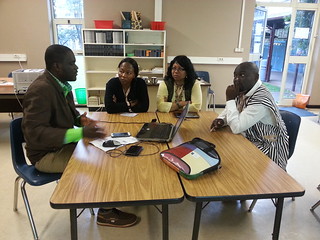Credential: of, pertaining to or entitling to credit or authority. From Medieval Latin credentialis (“giving authority”), from credentia (“trust”). From <http://en.wiktionary.org/wiki/credential>

Teaching is a profession, and our credentials are the first, necessary-but-not-sufficient condition for schools to entrust us with their students’ education. Our teaching certificates and degrees prove the rigor of our preparation. At least, this was the assumption that I labored under for much of my education. I applied to university by looking at US News and World Report’s list of the top ones. I did the same when I applied to graduate programs. It was a calculation that in the absence of my having done anything especially notable, it was a prestigious institution that could bestow upon me a credibility that would be acknowledged by employers and colleagues. In a world in the infancy of the Internet as a participatory force, it was not a bad strategy.
But in today’s world, there is a new credential. That credential is sharing, and last week’s Learning 2.014 conference in Addis Ababa showed me how powerful this new credential is. Learning 2 is a “flat” conference, one where teachers from the smallest, poorest school can present with equal authority as those from the largest, richest ones. It’s participant-driven, where the average attendee can have just as much impact as one of those presenters. It’s creating a new vocabulary and pedagogical culture for the classroom. And its model is increasingly becoming the way for teachers to demonstrate their credit and authority as educational professionals.
The “flat” model meant that sharing influenced attendance at the conference. The presenters came from four continents and half a dozen nations, had five to 25 years of teaching experience, taught at schools from 160 to 1600 students, and spanned the range from idealists to skeptics. We were united not by experience, philosophy, or background but by our common practice of sharing with their peers through social networks, through which the organizers contacted us and by which we were able to get the word out to conference participants.
The participant-driven model meant that those who shared had the most sway, and sharing was not limited to presenters. Presenters’ extended sessions occupied less than half of the schedule, with the rest occupied by short “Learn2Talks” on diverse topics, cohort discussions where teachers with similar responsibilities brainstormed solutions for their respective fields, “unconference” sessions based on topics selected by popular vote, and even “mindfulness” time for participants to reflect on what they had learned. Twitter served as a lively backchannel where participants shared more than presenters. And throughout, the organizers listened to what the participants were saying and adjusted the schedule, format, and logistics of the conference as appropriate. The conference was as dynamic and responsive as the pedagogy it sought to promote.
Most impressive was the fact that in this context of educators looking to promote change in education, it wasn’t your credentials that mattered. The only thing others knew about your background was your country, school, and Twitter handle. What mattered was how well you could articulate yourself to your audience, who would go on to share those ideas with their peers. It was how the concepts of “presenter,” “audience” and “peer” were really the same thing. I gave a session in which school directors participated alongside classroom teachers, and then went to workshops as a novice educational iPad user to learn from TAISM’s tech integrator. We all connected online so that we could continue a professional dialogue later. When I go looking for my next job, schools will still look at my teaching certificate and degrees. They’ll read my letters of recommendation and phone my references. But I also know that they will examine my network of peers that sprouts at conferences like this and that flourishes online.
Postscript: If you’re hosting a conference, what matters most is the culture you develop, and Learning2 is definitely creating its own culture. But then there’s the matter of logistics. I’ll leave you with a couple of things that could be optimized for next year:
- Have a master, hour-by-hour schedule on page on the conference website with links out to the different options for that hour. Consider making the schedule in an online calendar that people can subscribe to.
- In Africa, consider distance and cost of travel especially carefully. Cities on the same continent can still be as remote from each other as Paris is from Tokyo.
- Bring in the local telecoms provider to sell SIM cards and write your own instructions on how to activate 3G data plans. This will help your attendees stay connected, and it’s a much cheaper option for them than paying their hotel for WiFi.
- Provide a persistent storage medium for the conference materials. It will build your brand, and teachers might go back to them months later. I have a Powerpoint from JOSTI ’13 that I haven’t used yet but might next year.